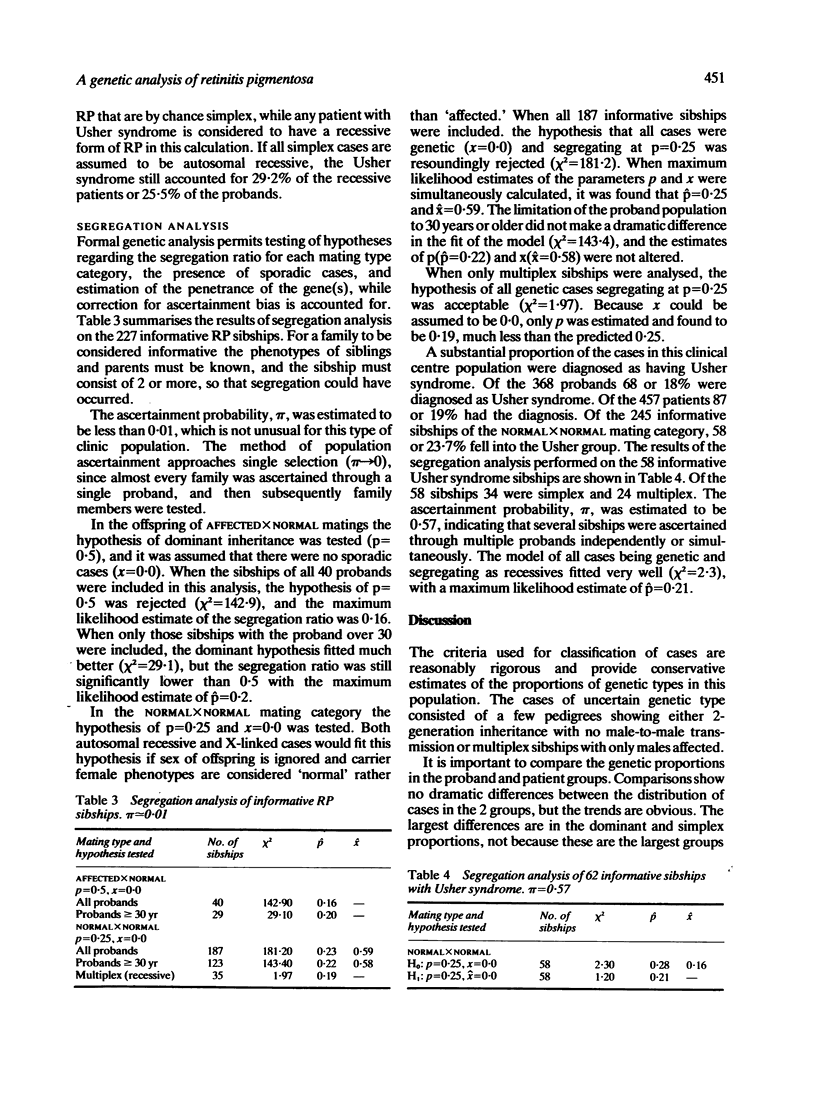Abstract
Genetic analysis of 457 patients with retinitis pigmentosa (RP) included categorisation of families by recognised mendelian pattern of inheritance and formal segregation analysis of all informative sibships. Of the 368 probands a surprisingly high 18% (68) had significant congenital loss of hearing and were diagnosed as having Usher syndrome. The RP probands were categorised as: 21.7% autosomal dominant, 9.0% X-linked, 16.0% autosomal recessive, 3.3% genetic type uncertain, and 50.0% simplex. Segregation analysis reflected this high proportion of simplex cases, accounting for reduced penetrance in dominant families; only 20% remain classified as sporadic (possibly nongenetic). In the matings between normal persons estimates of the segregation ratio also indicate lower values than expected. Unlike in RP sibship, segregation in the Usher syndrome is consistent with the hypothesis of recessive inheritance. Therefore RP with significant hearing loss segregates as expected, while even if a proband is classified as a dominant or recessive the recurrence risk for the RP phenotype may be below mendelian expectation.
Full text
PDF





Selected References
These references are in PubMed. This may not be the complete list of references from this article.
- Ammann F., Klein D., Franceschetti A. Genetic and epidemiological investigations on pigmentary degeneration of the retina and allied disorders in Switzerland. J Neurol Sci. 1965 Mar-Apr;2(2):183–196. doi: 10.1016/0022-510x(65)90079-1. [DOI] [PubMed] [Google Scholar]
- Aquirre G., Farber D., Lolley R., Fletcher R. T., Chader G. J. Rod-cone dysplasia in Irish setters: a defect in cyclic GMP metabolism in visual cells. Science. 1978 Sep 22;201(4361):1133–1134. doi: 10.1126/science.210508. [DOI] [PubMed] [Google Scholar]
- Berson E. L., Gouras P., Gunkel R. D., Myrianthopoulos N. C. Dominant retinitis pigmentosa with reduced penetrance. Arch Ophthalmol. 1969 Feb;81(2):226–234. doi: 10.1001/archopht.1969.00990010228013. [DOI] [PubMed] [Google Scholar]
- Davenport S. L., O'Nuallain S., Omenn G. S., Wilkus R. J. Usher syndrome in four hard-of-hearing siblings. Pediatrics. 1978 Oct;62(4):578–583. [PubMed] [Google Scholar]
- Fishman G. A. Retinitis pigmentosa. Genetic percentages. Arch Ophthalmol. 1978 May;96(5):822–826. doi: 10.1001/archopht.1978.03910050428005. [DOI] [PubMed] [Google Scholar]
- Hu D. N. Genetic aspects of retinitis pigmentosa in China. Am J Med Genet. 1982 May;12(1):51–56. doi: 10.1002/ajmg.1320120107. [DOI] [PubMed] [Google Scholar]
- Jay B. Hereditary aspects of pigmentary retinopathy. Trans Ophthalmol Soc U K. 1972;92:173–178. [PubMed] [Google Scholar]
- LaVail M. M. Analysis of neurological mutants with inherited retinal degeneration. Friedenwald lecture. Invest Ophthalmol Vis Sci. 1981 Nov;21(5):638–657. [PubMed] [Google Scholar]
- MORTON N. E. Genetic tests under incomplete ascertainment. Am J Hum Genet. 1959 Mar;11(1):1–16. [PMC free article] [PubMed] [Google Scholar]
- Panteleeva O. A. K voprosu o nasledstvennykh tapetoretinal'nykh degeneratsiiakh. Vestn Oftalmol. 1969 Jan-Feb;:53–56. [PubMed] [Google Scholar]


